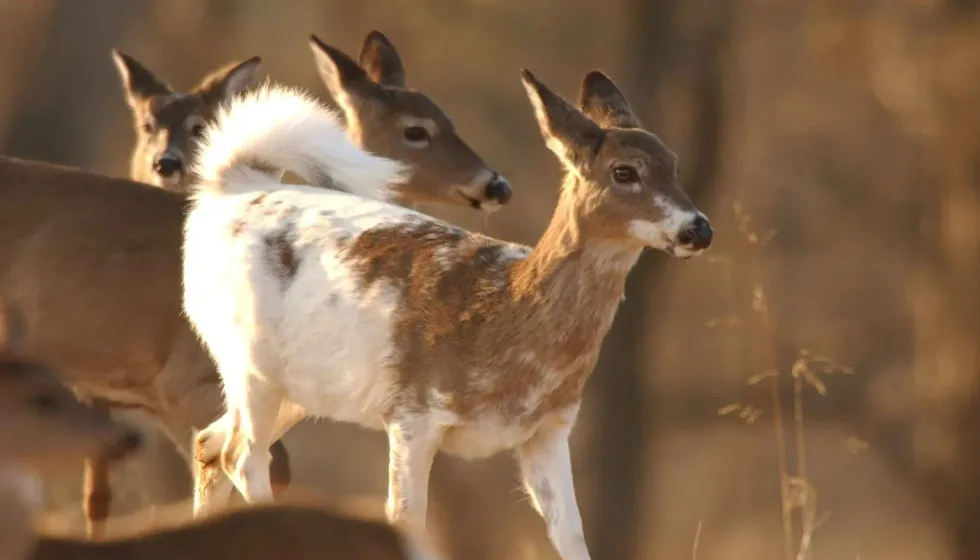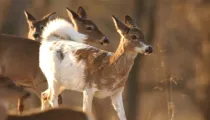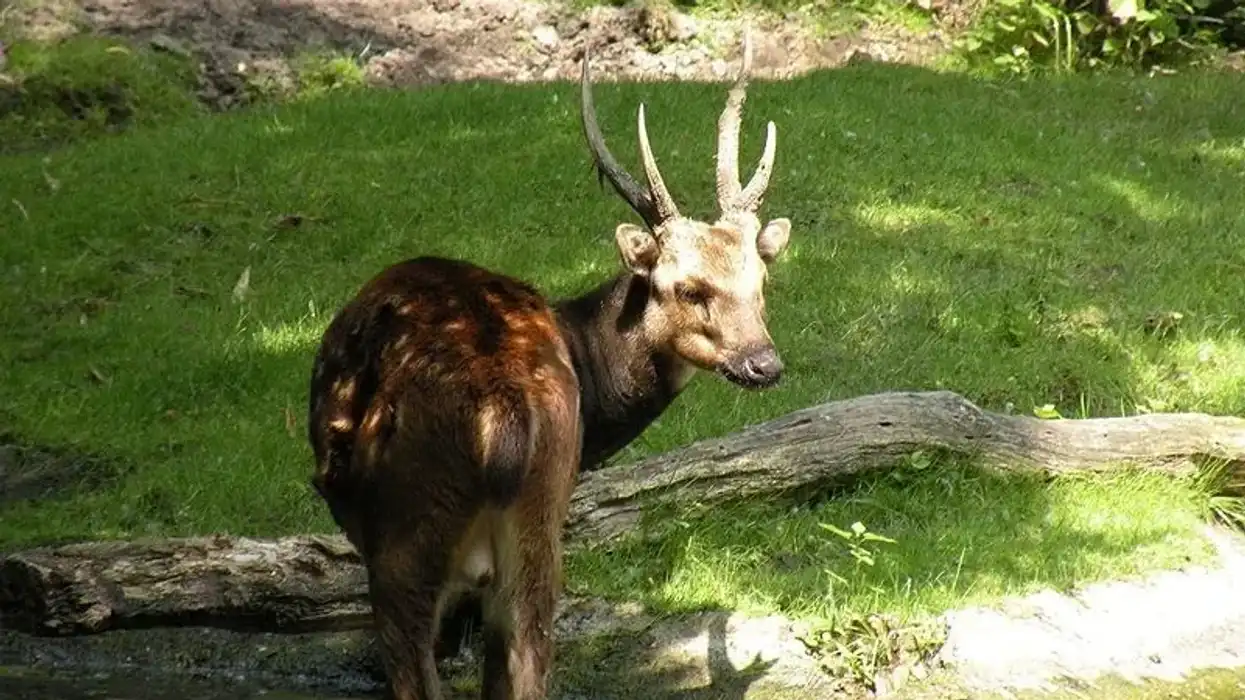Have you ever wanted to know more about deer? If yes, then keep on reading to learn about one of the most commonly found deer in the USA and southern Canada.
The white-tailed deer (Odocoileus virginianus), is popularly known as the whitetail deer. This is a medium-sized species of deer.
It is distinctly known for its grayish-brown or reddish-brown color which is complimented with white fur on its tail along with the white underside. The fur turns grayish-brown in winter, while the reddish-brown color is more visible in summer.
Male deer also have fantastic antlers which aren't present in female deer. The life span of this deer is about three to 10 years in the wild.
This species is known for hunting during dawn and dusk. As a timid species, its acute sense of hearing, as well as its enhanced eyesight, helps it to hide from predators and it can remain hidden for hours at a time.
These deer have a long gestation period of almost six and a half months. Apart from grass that the deer feeds on in spring and summer, it also feeds on buds and twigs found in its native habitat.
Keep on reading to learn more white-tailed deer facts. Also, check out our articles on reindeer and black-tailed deer.
White-Tailed Deer Interesting Facts
What type of animal is a white-tailed deer?
The white-tailed deer (Odocoileus virginianus) is a species of deer that is medium-sized.
What class of animal does a white-tailed deer belong to?
The whitetail deer belongs to the class Mammalia and the genus Odocoileus.
How many white-tailed deer are there in the world?
The white-tailed deer is a species that has around 38 subspecies and so, it will be very hard to put down the population. However, the number of deer present in the US is estimated to be 11,000,000 individuals. The North American deer population is significantly larger than the South American population. It isn't a rare deer.
Where does a white-tailed deer live?
The white-tailed deer is native to different areas of North America, Ecuador, South America, and Central America. In South America, this deer can be found in Bolivia.
However, this species has also been introduced to other countries like New Zealand and in several European countries. In the US, this deer is found in states like South Dakota, Oregon, Arizona, Michigan, Minnesota, New Hampshire, and New York. In southern Canada, states with the Rockies have a good population of whitetail deer.
What is a white-tailed deer's habitat?
The common whitetail deer habitat includes forests, farmland, and dense thickets. The deer is found in both temperate and tropical areas.
It can also be found in other terrestrial habitats. The North American population is often focused in Texas and parts of Mexico where these deers are found in sparsely vegetated hot deserts. Southern Canada habitats also have a considerable population of these deer.
Who do white-tailed deer live with?
The white-tailed deer is solitary. Only female deer can often be seen with fawns, that too only after the mating season. Sometimes grazing herds have been observed but that isn't common.
How long does a white-tailed deer live?
The white-tailed deer has a short life that lasts for three to 10 years. As it is one of the most common North American deer species, people often hunt it as a game.
How do they reproduce?
A female deer goes through yearly estrus (heat) cycles, while male bucks have something known as a rut. The rutting or mating season for this deer is usually in the winter months of October to December.
Bucks are polygamous, but mating only takes place once every year. The estrus cycle in female deer lasts for 24 hours. The average gestation period is 198 days or six and a half months.
Most females give birth to one fawn. However, some may even give birth to one or two fawns. Bucks do not take much responsibility, and the fawns are mainly raised by females.
The male deer will lose its antlers once the breeding season is over. Fawns reach sexual maturity by the first year after birth.
What is their conservation status?
The white-tailed deer is currently classified as a species of Least Concern in the International Union for Conservation of Nature (IUCN) Red List.
White-Tailed Deer Fun Facts
What do white-tailed deer look like?
The white-tailed deer looks quite simple with a color variation of grayish-brown in winter and a reddish-brown coat during the summer days. The gray-brown coat is contrasted with the white underside along with the white fur on the tail.
White fur is also present near its nose, eyes, in the chin and neck area, as well as on the legs. The antlers are the most striking things about the Bucks. Every year bucks shed their antlers from January to March and grow new antlers from April to May.
The physical features of some may change based on the subspecies. In general, the body is lean and medium-sized.
How cute are they?
The reddish-brown or gray-brown colored white-tailed deer are quite adorable. Fawns look cute especially because of their spotted fur coat which is complimented by the white underside.
How do they communicate?
One of the most important communication forms present in white-tailed deer is through their scent glands. Some of these glands are present on the inside and outside of the hind legs.
The scent helps deer to communicate with other deer, mainly in the mating season. Deers also use different types of vocalization, mainly grunts, bleats, and wheezes to communicate. A loud 'blatt' sound is made by a deer when it is injured.
How big is a white-tailed deer?
The average shoulder height of a white-tailed deer is 31.4-39 in (80-100 cm). While the average head-body length is 59-78.7 in (150-200 cm). The white-tailed deer is slightly smaller or equal in size to a mule deer that has an average height of 36-42 in (91-106 cm).
How fast can a white-tailed deer run?
White-tailed deer can run at great speeds of up to 30 mph (48 kph) when chased.
How much does a white-tailed deer weigh?
The average weight of a white-tailed deer is 125.5-301.7 lb (57-137 kg).
What are the male and female names of the species?
A male white-tailed deer is known as a buck and a female white-tailed deer is known as a doe.
What would you call a baby white-tailed deer?
Baby white-tailed deer are known as fawns.
What do they eat?
A white-tailed deer feeds on food and vegetation that is readily available in its habitat. Hence, it can feed on a lot of things. In habitats that are present on the eastern side, the main food for deer is buds and twigs of maple, aspen, and birch.
In deserts, the food is yucca, prickly pear cactus, ratama, and other hard-to-eat shrubs. When other food is scarce, deer eat grass. During the winter months, deer may even feed on conifers.
The white-tailed deer is crepuscular. This deer species is also attracted to crop fields. Some food sources include legumes or other crops. These deer may even feed on poison ivy and some other mushrooms that are inedible to humans.
As ruminants, deer have a four-chambered stomach. Even though deer eat shade-tolerant plants, this species isn't keen on them. The size of the antlers in bucks depends on the food intake.
Are they dangerous?
Not really! The white-tailed deer isn't aggressive or dangerous. It is rather shy and tries to protect itself from any predator that might follow it.
The deer will raise its tail when it senses something is wrong. Even in the rutting season, this deer species doesn't seem to fight for its territory, unlike other animals. These deer will never attack humans.
Would they make a good pet?
Again, not really! As autonomous wild animals, the whitetail deer deserves to stay in its natural habitat. Moreover, it can be illegal to keep this deer as your pet.
Did you know...
Deer are intelligent animals, so there are times when deer will recognize humans, especially if both of them cross paths quite frequently.
The light color of fawns helps them to camouflage with the forest floor and female deer may hide the fawns for four hours at a time.
Antlers are seen in some females and are associated with sterile females.
What is a white-tailed deer known for?
The white-tailed deer is best known for its great ability to see. This deer also has strong eyesight. Apart from that, whitetail deer bucks also shed and grow antlers every year. The white-tailed deer is also a good swimmer and it can easily get past large streams or lakes.
Do deer lay down to sleep?
Yes, a deer goes into its bedding position to sleep. Most deer spend a considerable amount of time laying down.
Here at Kidadl, we have carefully created lots of interesting family-friendly animal facts for everyone to discover! Learn more about some other mammals including Pyrenean ibex, or Ethiopian wolf.
You can even occupy yourself at home by drawing one on our white-tailed deer coloring pages.










